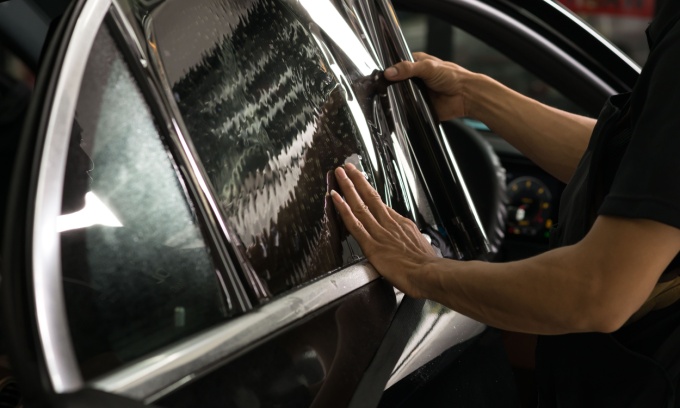Car window tinting can help ease the intensity of the sun and offer you some added privacy while you drive. Whatever your reason for considering a car window tint, it’s important to first understand the costs that come with tinting your windows, as well as what laws may apply in your state or territory regarding the darkness of the tint.
What is car window tinting?
Car window tinting can be fitted to new vehicles (factory tinting) or applied as a film to the glass of your windows after you’ve bought the car, generally with the intent to darken the glass. Tinting can be applied to the driver and passenger windows, as well as to the rear window of a car.
It cannot, however, legally be installed on a windscreen in most states and territories in Australia. An exception is usually made for visor strips that run across the uppermost part of the screen.
How much does car window tinting cost?
According to the Window Film Association of Australia and New Zealand (WFAANZ), the cost of car window tinting in Australia will generally range from $300 to $800, which includes the professional tinting of all of your car’s side and rear windows. Trades job listing website Oneflare by Airtasker suggests that average costs may vary between $200 to $500, depending on certain factors.
Some factors that may influence the cost of having your car windows tinted include the make, model and size of your vehicle, the brand and type of tint film you choose (e.g. dyed, metalised, hybrid, carbon or ceramic) and your desired look and features (e.g. scratch or fade-resistant, non-reflective). The table below details the expected costs for certain sized vehicles:
← Mobile/tablet users, scroll sideways to view full table →
| Vehicle type | Average cost ($) |
|---|---|
| Small Hatch | $225 to $325 |
| Sedan | $240 to $330 |
| SUV | $260 to $380 |
| Wagon | $260 to $380 (general pricing) |
| Large coupe | $320 to $430 |
| Utility vehicles (Utes) | $200 to $265 (single cab) |
| Vans and people movers | $200 to $280 (large vans) |
Source: Oneflare, 2025.
The cost could also vary depending on the state or territory you live in. Oneflare states the following average costs for the darkest legal tint in certain states:
- New South Wales: $250
- Queensland: $270
- Victoria: $300
- Western Australia: $300
Costs will also vary between professionals, so it’s usually a good idea to get quotes from a number of different service providers to help compare your options.
What is the best tint for car windows?
There is not necessarily one tint that is the best for car windows, as it will depend on what you need a tint for, and whether you are interested in it for aesthetic or practical reasons, or a mixture of both. It can be a good idea to speak to an experienced installer to find out more about the best tint for your needs, particularly considering that there are legal limits to what tint you may be able to choose (depending on which state or territory you live in).
Benefits of tinting car windows
Tinting your car windows can have a number of potential benefits. The WFAANZ says that adding a tint to your car windows can be beneficial for the following reasons:
UV protection
Tinting can help prevent heat, glare and harmful UV (ultraviolet) rays from penetrating the window’s glass. It can provide protection to the driver, passengers and interior of the car from sun damage, and potentially reduces the need for air conditioning.
Safety
The ultra-thin film can add strength to the glass, which could reduce the risk of injury in a road accident and help to prevent break-ins.
Privacy
Darkened glass can provide a level of privacy for vehicle occupants while on the road and help to hide a car owner’s belongings from prying eyes.
Improved appearance
Some drivers feel window tinting achieves a smarter, sleeker look for their vehicle, and with a range of colours and styles available, you have control over the final aesthetic look. It may also help to preserve the interior of your car and lessen fading caused by the sun.
Reasons against tinting your car windows
Despite WFAANZ’s claim that car window tinting can cut down on UV radiation and reduce heat, the Cancer Council of Australia has found that ordinary tempered automotive glass already blocks out UVB radiation (short-wave ultraviolet light) and as high as 79% of UVA (long-wave ultraviolet light) radiation. Laminated glass (used in windscreens and some side windows) also blocks out UVB radiation and as much as 98% of UVA rays. The Cancer Council of Australia does state, however, that clear or tinted films can help reduce the amount of UVA rays penetrating tempered glass by over 99%.
Roadside assistance and insurance provider NRMA also warns that the heat reduction claims of window tinting can be overstated. Factors like your windscreen and roof will also contribute to the temperature inside your vehicle, so it can be important to not only rely on window tinting to keep in-car temperatures down, especially when parked in the full sun. They also suggest that car window tinting may make it harder to see in low-light conditions and could be seen as a negative feature by potential buyers if you plan on selling your car in the future.
It can be important to consider potential benefits and downsides such as these before deciding whether to tint your car windows.
How long will car window tinting take to install?
On average, it will take a professional a couple of hours to tint four standard side windows and the rear window in a sedan. You can request an estimate of how long it will take directly from the provider you have chosen.
Where can you get your car windows tinted?
Car window tinting services may be offered by auto tinting companies, auto service shops, and motoring clubs. The WFAANZ suggests customers choose a professional installer who will abide by all state or territory guidelines and can provide a warranty on the film and the installation. This may allow replacements or corrections to be made if the tint film bubbles, peels, fades, cracks or comes off the windows after installation.
WFAANZ members who have made a commitment to comply with these standards and regulations can be found in the members directory on the WFAANZ website.
Darkest legal tint: What are the car window tinting laws?
In Australia, the maximum darkness for after-market and factory car window tinting is set and regulated by state and territory road and traffic authorities, often referred to as the ‘darkest legal tint’. If you deviate from the car tinting rules set out by your state or territory authority, then the WFAANZ says you could render your car unroadworthy.
This could mean that as well as having to pay to remove the tinting from your car, your registration or insurance policy may be cancelled, and you could face a fine or even criminal charges if the tinted windows prove to be a contributing factor in an accident.
Window tint darkness is measured in Visible Light Transmission (VLT), which is the amount of light that can pass through your window. The lower the VLT percentage, the darker the film.
What is the legal minimum window tinting VLT percentage by state?
The window tinting rules in each state and territory for the side and rear windows at the time of writing are outlined below:
Darkest legal tint ACT
The darkest legal tint on a standard car in the Australian Capital Territory is:
- Front side windows (VLT%): 35%
- Rear side windows (VLT%): 20%
- Rear window (VLT%): 20%
Darkest legal tint NSW
The darkest legal tint in New South Wales is:
- Front side windows (VLT%) 35%
- Rear side windows (VLT%): 20%
- Rear window (VLT%): 20%
Darkest legal tint NT
The darkest legal tint in the Northern Territory is:
- Front side windows (VLT%): 35%
- Rear side windows (VLT%): 15%
- Rear window (VLT%): 15%
Darkest legal tint Qld
The darkest legal tint in Queensland is:
- Front side windows (VLT%): 35%
- Rear side windows (VLT%): 20%
- Rear window (VLT%): 20%
Darkest legal tint SA
The darkest legal tint in South Australia is:
- Front side windows (VLT%): 35%
- Rear side windows (VLT%): 20%
- Rear window (VLT%): 20%
Darkest legal tint Tas
The darkest legal tint in Tasmania is:
- Front side windows (VLT%): 35%
- Rear side windows (VLT%): 20%
- Rear window (VLT%): 20%
Darkest legal tint Vic
The darkest legal tint in Victoria is:
- Front side windows (VLT%): 35%
- Rear side windows (VLT%): 20%
- Rear window (VLT%): 20%
Darkest legal tint WA
The darkest legal tint in Western Australia is:
- Front side windows (VLT%): 35%
- Rear side windows (VLT%): 20%
- Rear window (VLT%): 20%
In almost all states and territories, windscreens cannot be tinted except for a small tinted strip along the uppermost 10% of the windscreen, above the wipers. In Tasmania, a 70% VLT can be applied to the windscreen, whereas in Western Australia, no applied film is allowed on windscreens at all.
Can car window tinting affect your car insurance?
If your car window tinting does not comply with the laws in your state or territory, then your vehicle could be rendered unroadworthy. Some car insurance providers may not pay a claim if it was found you were driving an unroadworthy vehicle at the time of an accident. It’s important to note the restrictions in other states and territories, if you plan on travelling through them with your tinted windowed vehicle.
Car modifications, including window tinting, may also bump up your car insurance premium costs if they are found to increase your risk of having an accident. Before you tint your windows, it could be worth informing your insurance provider, so they can let you know if the tinting is covered by your current policy or if it will impact your insurance premium.
Compare car insurance policies
If you’re comparing car insurance policies, the comparison table below displays some of the policies currently available on Canstar for a 30-39 year old male seeking comprehensive cover in NSW without cover for an extra driver under 25. Please note the table is sorted by Canstar Star Rating (highest to lowest) followed by provider name (alphabetical) and features links direct to the providers’ websites. Consider the Product Disclosure Statement (PDS) and Target Market Determination (TMD), before making a purchase decision. Contact the product issuer directly for a copy of the PDS and TMD. Use Canstar’s car insurance comparison selector to view a wider range of policies. Canstar may earn a fee for referrals
- Save 15%^ on your first year’s premium when you purchase a new Car Insurance policy online.
- 24/7 Phone & Online Claims.
- Budget Direct - Insurance Solved.
- Insurance that's a bit more you-shaped.
- Canstar’s 2025 Most Satisfied Customer Car Insurance – NSW, VIC, SA
- Lodge a Claim 24/7 with our Advisors
- Flexible cover before, 24/7 claims after.
- Save $75 on new Comprehensive car insurance online.
- Conditions apply.
- No age-based excess.
- No excess on your first covered windscreen repair.
- Canstar 2025 Outstanding Value Car Insurance Award.
- Boxing Day Sale: Complimentary Roadside Assistance for 12 months. Choose your own repairer. Up to 10% off your first year's premiums. $10 monthly kogan.com credit
Additional reporting by Nick Whiting.
Cover image source: Bhakpong/Shutterstock.com








